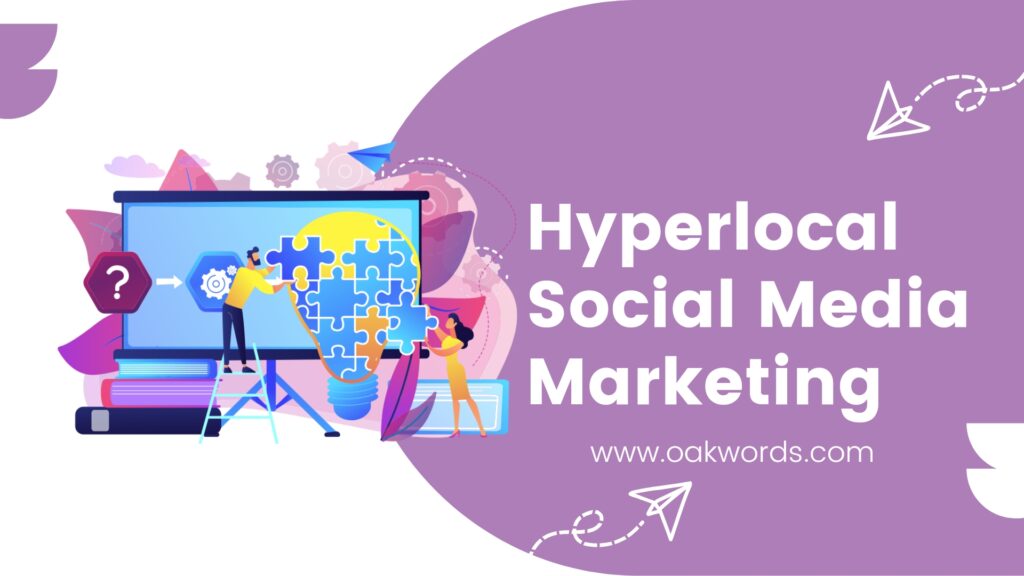
Hyperlocal social media marketing is a way for businesses to promote themselves to people in very specific local areas.
Instead of reaching a broad audience, they focus on connecting with customers in nearby neighbourhoods.
This involves using social media platforms to share targeted content, ads, and promotions that are relevant to people in a specific location.
The goal is to engage with the community on a more personal level and attract customers who are close by.
Hyperlocal social media marketing can efficiently lower the cost, personnel, and methods of distributing ads inside a certain region by using a focused approach to local customers, who are often located within a few miles of your business’s location.
With the help of hyperlocal social media marketing, you can produce excellent, relevant, and personalized content that increases engagement and conversion rates.
Rather than using a “one-size-fits-all” strategy, businesses can create highly relevant products and services for a specific set of individuals by efficiently targeting local consumers.
Benefits of Hyper-Local Marketing
1. Improved Engagement and Interaction
By closely monitoring and understanding the needs of local customers, businesses can easily build trust and loyalty, and of course, more profits.
2. A Sense of Community and Connection
Establishing a strong relationship with local customers is a must for businesses. And focusing on local landmarks, and sharing information about attractions, news and events can be very helpful in building a relationship between businesses and potential customers.
This also allows businesses to create a bond with other local businesses and opens the doors for potential collaborations and partnerships.
3. Higher Conversion Rate
Businesses can accurately attract buyers who are more likely to be interested in their products and services by focusing on a particular geographic area and creating content according to the needs and interests of the local audiences.
Better conversion rates can be achieved with this focused strategy because the target demographic is already responsive to and has an understanding of the brand’s messaging.
4. Reduced Advertising Costs
Speaking with local clients directly reduces advertising expenses through hyperlocal social media marketing. On social media sites like Facebook, businesses target certain communities rather than the general public.
This targeted strategy reduces pointless clicks from visitors from other countries, saving money. Promos that revolve around regional interests increase engagement and increase the effectiveness of every advertising spend.
Businesses may optimize impact while minimizing costs by focusing on the community and developing an affordable approach that establishes a direct connection with the people who matter most.
5. Ability to Replicate Successful Strategies
Because hyperlocal social media marketing focuses on what works in particular neighbourhoods, it improves the capacity to replicate successful strategies.
Applying a business’s successful strategy—such as a well-crafted article or focused promotion—to comparable areas gets easier when it discovers a winning formula. Businesses can reproduce successful strategies and modify them for different regions by knowing the distinct preferences of each community.
With careful tuning to resonate with the unique interests and habits of each local audience, hyperlocal social media marketing ensures constant success.
6. Effective Ways to Establish a Niche
Hyperlocal social media marketing helps businesses carve out a special place in their neighbourhood. By sharing tailored content that speaks directly to local interests and needs, businesses can stand out and become the go-to choice in their community.
From highlighting local events to offering exclusive promotions, this personalized approach creates a niche where businesses can thrive and connect with their neighbours on a deeper level, fostering loyalty and trust.
7. Multiple Platforms for Strong Brand Story
Hyperlocal marketing focuses on reaching a very specific local audience. By using multiple platforms like Facebook, Instagram, and Twitter, businesses can tell their brand story to people in a particular neighbourhood or community.
This approach ensures that the message resonates with the local audience, creating a stronger connection and increasing the chances of customers engaging with and supporting the business.
Is it For Your Business?
Any business that serves clients in a particular geographic area or has a physical presence can benefit from hyperlocal marketing. Small and neighbourhood companies that provide services, such as eateries, coffee shops, boutiques, hair salons, gyms, and other businesses, fall under this category.
Larger companies with numerous locations may also benefit from hyperlocal marketing since it enables them to customize their advertising strategies for each area and its particular clientele. In general, hyperlocal marketing helps companies whose sales are mostly driven by foot traffic or local clients.
These companies sell goods and services that people would rather buy in person than online. These could be a yoga studio that offers group sessions, a boutique selling handcrafted goods, or a restaurant that serves regional cuisine.
Hyperlocal Social Media Marketing Best Practices

1. Local Content Creation:
Create content that highlights your business in the context of the local community. Share stories, events, and news relevant to the area.
This could include featuring local customers, showcasing community involvement, or discussing neighbourhood happenings. By tailoring your content to the local scene, you’ll capture the attention and interest of your immediate audience.
2. Geo-Targeted Ads:
Utilize geotargeting features on social media platforms. This means showing your ads specifically to people in a certain location. This ensures that your promotions reach those who are most likely to visit your local business.
For example, you can target users within a certain radius of your store or in a particular zip code.
3. Local Influencer Collaborations:
Partner with local influencers or community figures who have a strong following in your area. Their endorsement or promotion of your business can reach a broader local audience and build trust within the community.
Consider influencers who align with your brand and have a genuine connection with the local people.
4. Engagement with Local Events:
Actively participate in and promote local events. This could involve sponsoring a community gathering, setting up a booth at a local fair, or supporting charity events.
Social media posts about your involvement in these activities not only contribute to your brand’s positive image but also connect you with residents who attend or engage with these events.
5. Customer Reviews and Testimonials:
Encourage satisfied customers to leave positive reviews on your social media pages. Highlighting these testimonials showcases the positive experiences of locals with your business.
Potential customers often trust the opinions of their peers, so positive reviews can be a powerful tool in attracting new business from the local community.
In short, hyperlocal social media marketing involves tailoring your content, ads, and collaborations to resonate with the immediate community. It’s about creating a strong local presence, building trust, and fostering connections with the people in your neighbourhood.
Which Social Media Platform is Suitable for Your Business?

Before starting your hyperlocal marketing journey, it is also important for you to understand which platform is suitable for your business.
Along with other strategies, a better understanding of the right platform will help you to target your potential customers effectively and that too, without pushing your financial limit.
Here is a brief overview of how different social media platforms are suitable for different types of local businesses.
1. Facebook, the Community Hub:
Despite the emergence of other platforms, Facebook is still the heart of the social media world. It’s great for local businesses wanting to create a community vibe. You can share updates, and events, and engage with customers through posts and comments. This works well for local cafes, boutiques, or service providers looking to foster a sense of belonging.
2. Instagram, the Visual Storyteller:
For businesses relying on visuals, like bakeries, salons, or artists, Instagram is a go-to platform. It’s all about eye-catching photos and short videos. Showcase your products, services, and behind-the-scenes glimpses to draw in the local crowd with a visually appealing narrative.
3. X (Twitter), the Real-Time Connector:
If your business thrives on real-time updates and quick interactions, Twitter can be your ally. Restaurants, food trucks, and event organizers can benefit from tweeting about daily specials, pop-up events, or live updates. It’s like announcing your services to the neighbourhood but in a digital, more effective way.
4. LinkedIn, the B2B Booster:
For hyperlocal businesses catering to other businesses (B2B), LinkedIn is essential. It’s not just for big corporations; local consultants, suppliers, or professional services can connect and network effectively in their local business community.
5. Next door, the Neighborhood Network:
Consider Nextdoor as the virtual neighbourhood watch. It’s a platform specifically designed for local communities, making it ideal for businesses like home services, local shops, or even dog walkers. Here, you can share your expertise, offer exclusive deals, and become a trusted part of the local network.
Conclusion
In conclusion, hyperlocal social media marketing is all about connecting with people in your neighbourhood or community through online platforms.
By understanding the ins and outs of hyper-local marketing, you can tap into its benefits, such as building trust, increasing customer loyalty, and boosting sales within your immediate area. However, it’s important to assess whether this strategy suits your business model.
If you decide to dive in, following best practices like personalized content and community engagement can maximize your success. Choosing the right social media platform tailored to your business needs is crucial.
In a nutshell, hyperlocal social media marketing is a powerful tool for small businesses to thrive locally by fostering meaningful connections in the digital landscape.
People Also Asked (PAA):
What is hyperlocal social media marketing?
Hyperlocal social media marketing is a way for businesses to connect with nearby customers using social platforms. It focuses on targeting a very specific local audience, like people in a neighbourhood or town.
This type of marketing is super targeted, sharing content that’s relevant to people in that specific area. It helps businesses reach and engage with potential customers in their immediate vicinity.
What is an example of hyper-local marketing?
Hyper-local marketing is like when a small business focuses its advertising on a very specific area, like a neighbourhood or even a street.
For example, a local bakery might use hyper-local marketing by putting up signs only in their neighbourhood or offering special deals to people nearby. It’s all about reaching the folks who
What are the advantages of hyper-local marketing?
Hyper-local marketing has several benefits. Firstly, it allows businesses to connect with customers in a specific area, increasing relevance. This personalized approach enhances customer engagement and loyalty.
Secondly, it helps businesses target their audience more precisely, leading to higher conversion rates. Localized promotions can attract nearby customers who are more likely to visit the store.
Thirdly, hyper-local marketing is cost-effective, as it focuses resources on a specific location. Lastly, it boosts community relationships, fostering a sense of local support.
Overall, hyper-local marketing maximizes impact by tailoring strategies to the immediate needs and preferences of a specific community.
Is localization a marketing strategy?
Yes, localization is a marketing strategy. It means adapting products or content to fit the preferences and needs of a specific local market. This helps businesses connect better with customers by using language, cultural references, and practices that are familiar to them.
By doing this, companies can make their products or messages more appealing and relevant, increasing the chances of success in different regions.



Pingback: Content Monitoring: 7 Smart Process to improve your content